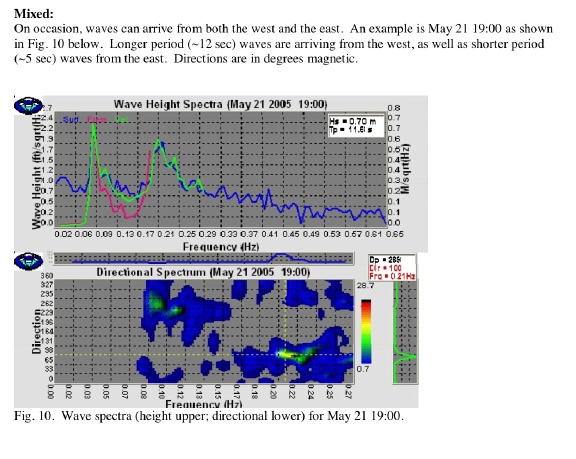
This file is extracted from a report of the analysis of the data by Rick Birch of ASL from the ADCP deployment at Site 2.
Below is the wave height spectra for site 2. During the time of deployment, two significant storm events occured. The results show up very well in the graphs
This provides a sample of the type of data we logged when we used an ADCP deployed in the spring of 2006:Wave Data from ADCP Deployment at Site 2.

Below is an interesting set of data that documents the behaviour of waves arriving from two directions at the same time. 
Wave Energy as an Abiotic Factor Determining the Distribution of Organisms at Race Rocks
When one is on the island during a storm, the impact of wave energy is certainly obvious. The docks are awash making it impossible to launch a boat and further providing a great deal of force on the organisms living in the upper intertidal zone.<bulletlist>
- Waves bring debris that can impact directly on mussels and goose-neck barnacles, however the adaptations of those animals as well as the intertidal algae have ensured that they remain clinging (for the most part) to the rocky substrate.
- The energy flow of many species of marine algae involves wave energy depositing them on shore.
- Wave energy also brings rocks and other aggregates onto the shore.
- The evolution of shorelines and shoreline ecosystems is also the result of wave energy.
- Waves carry salt water sea spray far inland as well. This restricts the kind of plants which can survive near shorelines. Certain plants survive only with the benefit of salt spray however, such as the Romanzoffia tracyi.
- One of our concerns with all Ecological reserves with shoreline borders is that any spill at sea of oil or chemicals which can wash up on shorelines could have consequences for the ecosystems of ecological reserves far inland.
- Rarely do abiotic factors act alone. A good example at Race Rocks is that they cause “surge or swell” which causes water to reach higher levels on the shore.
- Another good example is wind energy and currents combine to form standing waves in current channels at Race Rocks.
See the other posts on this website about waves:
 |
Ocean Wave Model ForecastsWaveModel |
